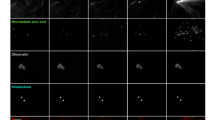Abstract
Nuclear envelope is a dynamic structure in the cell cycle. At the beginning of mitosis, nuclear envelope breaks down and its components disperse into the cytoplasm. At the end of mitosis, nuclear envelope reassembles using the dispersed components. Searching for the mechanisms of the nuclear disassembly and reassembly has for a long time been one of the key projects for cell biologists. In this report we show that microtubules take a role in the nuclear envelope assembly around the sperm chromatin inXenopus egg extracts. Microtubule cytoskeleton has been demonstrated to take roles in the transport of intracellular membranes such as Golgi and ER vesicles. We found that the nuclear envelope assembly needs functional microtubules. At the beginning of the nuclear assembly, microtubules nucleated to form a microtubule aster around the centrosome at the base of the sperm head. Using the microtubule drug colchicine to disrupt the microtubule nucleation, nuclear envelope reassembly was seriously inhibited. If the microtubules were stabilized by taxol, another microtubule drug, the nuclear envelope reassembly was also interfered, although a significantly large aster formed around the chromatin. Based on these observations, we propose that microtubules play an important role in the nuclear envelope reassembly maybe by transporting the nuclear envelope precursors to the chromatin surfaces.
Similar content being viewed by others
References
Gant, T. M., Wilson, K. L., Nuclear assembly, Annu. Rev. Cell Dev.Biol., 1997, 13: 669–95.
Vasu, S. K., Forbes, D. J., Nuclear pores and nuclear assembly, Curr. Opin. Cell Biol., 2001. 13: 363–75.
Lohka, M. J., Masui, Y., Formationin vitro of sperm pronuclei and mitotic chromosomes induced by amphibian ooplasmic components, Science, 1983, 220: 719–721.
Vigers, G. P. A., Lohka, M. J., A distinct vesicle population targets membranes and pore complexes to the nuclear-envelope in Xenopus Eggs, J. Cell Biol., 1991, 112: 545–556.
Drummond, S. et al., Temporal differences in the appearance of NEP-B78 and an LBR-like protein during Xenopus nuclear envelope reassembly reflect the ordered recruitment of functionally discrete vesicle types, J. Cell Biol., 1999, 144: 225–40.
Newport, J., Dunphy, W., Characterization of the membrane binding and fusion events during nuclear envelope assembly using purified components, J. Cell Biol., 1992, 116: 295–306.
Hughes, M. et al., The role of the ran GTPase in nuclear assembly and DNA replication: characterisation of the effects of Ran mutants, J. Cell Sci., 1998, 111: 3017–26.
Zhang, C., Clarke, P. R., Chromatin-independent nuclear envelope assembly induced by Ran GTPase in Xenopus egg extracts, Science, 2000, 288: 1429–32.
Zhang, C., Clarke, P. R., Roles of Ran-GTP and Ran-GDP in precursor vesicle recruitment and fusion during nuclear envelope assembly in a human cell-free system, Curr. Biol., 2001, 11: 208–12.
Zhang, C. et al., Concentration of Ran on chromatin induces decondensation, nuclear envelope formation and nuclear pore complex assembly, Eur. J. Cell Biol., 2002, 81: 623–33.
Zhang, C., Hughes, M., Clarke, P. R., Ran-GTP stabilises microtubule asters and inhibits nuclear assembly inXenopus egg extracts, J. Cell Sci., 1999. 112: 2453–61.
Zhang, C. et al., Role of importin-beta in the control of nuclear envelope assembly by Ran, Curr. Biol., 2002, 12: 498–502.
Hetzer, M. et al., GTP hydrolysis by Ran is required for nuclear envelope assembly, Mol. Cell, 2000, 5: 1013–24.
Hetzer, M. et al., Distinct AAA-ATPase p97 complexes function in discrete steps of nuclear assembly, Nat. Cell Biol., 2001, 3: 1086–91.
Dabora, S. L., Sheetz, M. P., The Microtubule-dependent formation of a tubulovesicular network with characteristics of the Er from cultured-cell extracts, Cell, 1988, 54(1): 27–035.
Allan, V. J., Vale, R. D., Cell-Cycle Control of Microtubule-Based Membrane-Transport and Tubule Formationin vitro, J. Cell Biol., 1991, 113: 347–359.
Lowe, M., Nakamura, N., Warren, G., Golgi division and membrane traffic, Trends in Cell Biology, 1998, 8: 40–44.
Watermanstorer, C. M. et al., Membrane/microtubule tip attachment complexes (tacs) allow the assembly dynamics of plus ends to push and pull membranes into tubulovesicular networks in interphaseXenopus egg extracts, J. Cell Biol., 1995, 130: 1161–1169.
Ewald, A. et al., Microtubule-dependent assembly of the nuclear envelopein Xenopus laevis egg extract, Eur. J. Cell Biol., 2001, 80: 678–91.
Arnal, I., Wade, R. H., How Does taxol stabilize microtubules, Current Biology, 1995, 5: 900–908.
Hartl, P. et al., Nuclear assembly with lambda DNA in fractionated Xenopus egg extracts: an unexpected role for glycogen in formation of a higher order chromatin intermediate, J. Cell Biol., 1994, 124: 235–48.
Lu, P., Zhai, Z. H., Nuclear assembly of demembranated Xenopus sperm in plant cell-free extracts from Nicotiana ovules, Exp. Cell Res., 2001, 270: 96–101.
Author information
Authors and Affiliations
Corresponding author
About this article
Cite this article
Yang, N., Chen, Z., Lu, P. et al. The microtubule aster formation and its role in nuclear envelope assembly around the sperm chromatin inXenopus egg extracts. Chin. Sci. Bull. 48, 1912–1918 (2003). https://doi.org/10.1007/BF03183977
Received:
Accepted:
Issue Date:
DOI: https://doi.org/10.1007/BF03183977




